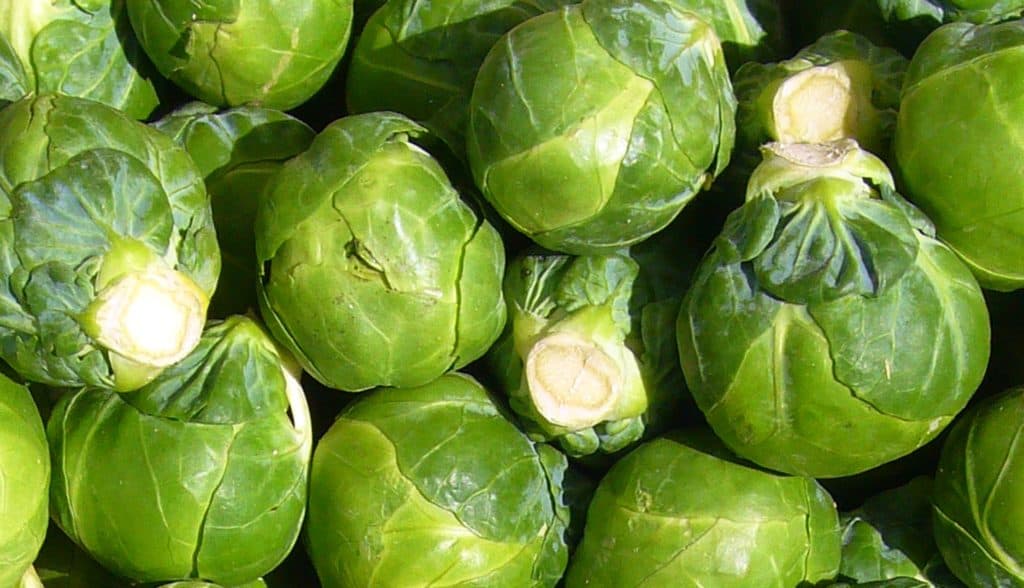Growing Brussels sprouts is super easy. This healthy vegetable is fun and simple to grow if you have a garden in the proper climate and provide adequate water.
Brussels Sprout Basics
First of all, Brussels sprouts (commonly written as “brussel sprouts”) enjoy cool weather but not frost, so if you are in the United States, you’ll need to wait to plant them until the end of April. This date will vary based on:
- how far north you are
- if you are using a plant tunnel
- if the plants are next your house
- … and similar factors, like wind conditions in your area (more wind means less frost).
In the spring, plant the seeds in a 1/2″ deep hole, about 4 inches apart. Put rows every 12 inches for a nice harvest. These plants grow to be about 24 to 36 inches tall, so they can be planted in the garden without fear of blocking the sun from any low lying plants nearby. They aren’t climbing so there is no need for a nearby wall or trellis.
You can Brussels sprouts in containers or pots on the patio, but you’ll need to water them frequently as containers do dry out quickly! These are a great container garden place because they are so good looking and they get a nice height without growing wider than the pot.
Planting Brussels Sprouts
Brussels sprouts like a good soil to grow in. It will need to be a sandy loam with lots of compost added to it. Make sure your soil is high in nitrogen and phosphorus. The soil should be loose and should be worked to a depth of 6 inches if you opt for a garden instead of a container. This loosening of the soil is particularly important if you live in an area with a lot of clay.
Growing Conditions
Brussels Sprouts should be planted in full sun. If you can’t get full sun then you can look for a spot with a minimum of 6 hours a day of direct sun light (not reflected light from a building or wall).
You don’t want to plant them too close together, or they will compete for nutrients, but reason you want to plant them so far apart is because you will need space to harvest them.
Growing Brussels sprouts isn’t difficult since they aren’t picky. However, you will need plenty of water, especially if you plan to grow them in pots. They will be a good addition to a container garden as the plants are attractive and will start the season early.
Brussels Sprouts Care
Brussels sprouts are easy to care for. Once the seedlings are established, they will need plenty of water. Water them every day, but make sure that the soil doesn’t get soggy. You may need to fertilize the plants about 3 weeks after they are established, and you can add a balanced fertilizer to the soil.
Brussels sprouts need to be picked when they are between 1/2″ and 1.25″ inches in size. You will want to pick them before the buds start to swell. When you harvest Brussels sprouts, you should cut the plant at the base of the plant.
Brussels Sprout Problems
Brussels sprouts can be attacked by the same pests that attack cabbage, which include cabbage moths, cabbage worms, cutworms, and root maggots.
In some areas, cabbage worms can be quite destructive. If you notice that you have a cabbage worm problem in your Brussels sprouts, you can need to spray your plants with neem oil or a similarly food-safe solution. You can also pick the worms off the plant and squash them. Some gardeners have had great success by hand-picking the worms.
If you have a problem with cutworms, you can sprinkle red pepper around the base of the plant to keep them away. We’ve tried this method with mixed success.
Brussels sprouts can also be attacked by flea beetles which eat tiny holes in the leaves of the plant. Flea beetles can be very destructive, so you will want to spray the plant with a pyrethrum spray to get rid of them. Make sure you spray the underside of the leaves as well.
Diseases
Brussels sprouts aren’t susceptible to many diseases, which is great news. However, they can be attacked by downy mildew, which is a fungal disease. You can use copper spray on the leaves to get rid of downy mildew, and you can also use neem oil to keep the disease away.
Happy growing!

